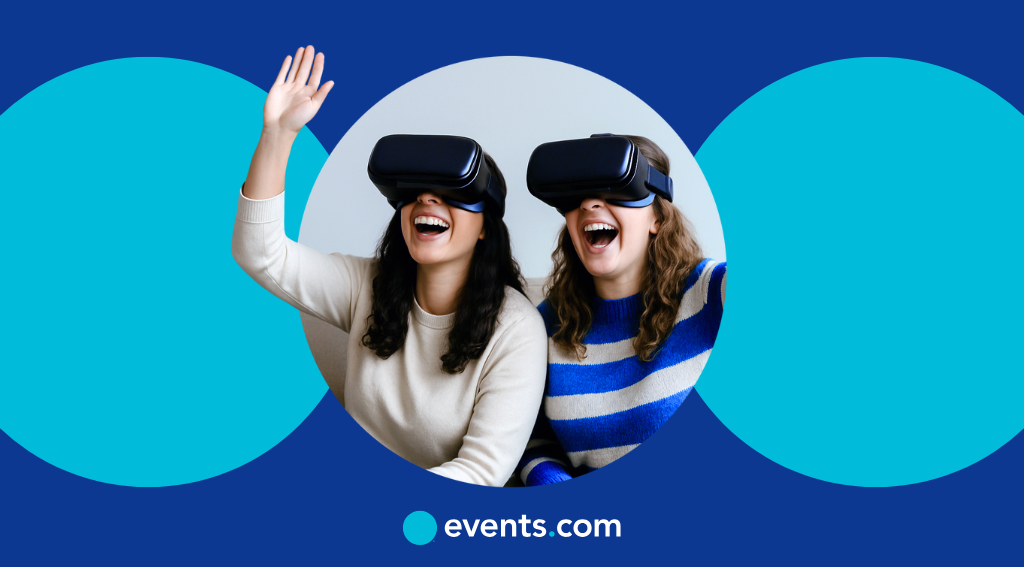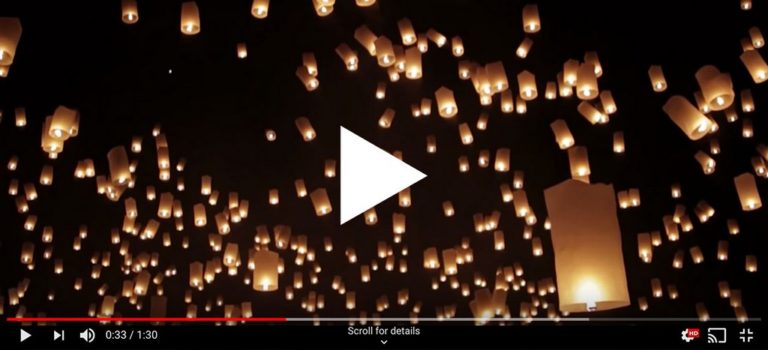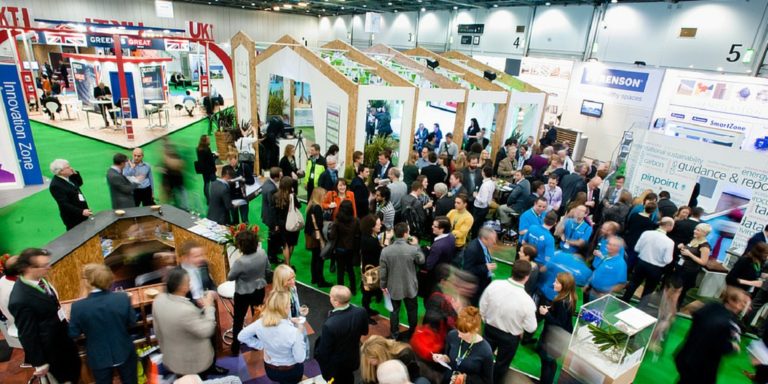Ever pointed your phone at a QR code and watched something come to life on your screen? That’s augmented reality, or AR for short. In simple terms, augmented reality for events means overlaying digital content onto real-world environments to turn ordinary moments into interactive experiences.
So, what does augmented reality actually look like at events? Practically, it’s executed through AR scavenger hunts, interactive signage, or virtual try-ons—digital layers that turn everyday moments into engaging experiences. Whether it’s a local food crawl, a global virtual summit, or a hybrid expo that blends both, AR adds that immersive spark. From scanning a banner to unlock a speaker’s intro video to placing a virtual product demo in your living room, AR lets your audience explore, connect, and share in fresh, memorable ways.
It’s not just flashy tech. Augmented reality helps you boost engagement, spotlight sponsors, and create memorable, high-impact moments, no matter where your attendees are.
AR vs. VR vs. MR vs. XR: what’s the difference?
Let’s break it down.
- Augmented Reality (AR) adds digital elements to the real world. Think interactive filters, 3D pop-ups, or scan-to-play games at a booth.
- Virtual Reality (VR) is fully immersive—you’re placed inside a completely digital environment, usually with a headset.
- Mixed Reality (MR) blends the physical and digital worlds so they can interact in real time. Imagine placing a virtual product on a real table and walking around it.
- Extended Reality (XR) is the umbrella term that covers AR, VR, and MR, basically, any experience that merges physical and virtual environments in some way.
For event creators, AR often leads the pack, because it’s accessible. No special gear needed, just a smartphone and a little curiosity.
Why augmented reality for events is booming in 2025
In 2025, augmented reality for events has evolved from novelty to necessity. Here’s why it’s booming:
- It’s already in your attendees’ pockets. Most smartphones are AR-ready, which means you can roll out interactive features without needing custom apps or extra hardware.
- It’s built into the platforms your audience already loves, like Instagram, TikTok, and Snapchat. Adding branded AR effects to your event is an easy way to tap into those habits and extend your reach.
- And it bridges every event format. Whether you’re planning an in-person festival, a livestreamed fundraiser, or a hybrid leadership summit, AR creates shared, real-time moments that make attendees feel seen and involved, wherever they are.
How augmented reality for events enhances every format
Now that we’ve covered what AR is and why it’s trending, let’s look at how augmented reality for events is showing up across formats. Whether your audience is at the venue, tuning in remotely, or somewhere in between, AR brings energy and interaction to every experience.
In-person events
Imagine a product booth where attendees scan signage to launch a 3D demo, or a scavenger hunt that leads guests around the venue using AR clues. From reactive signage to branded mini-games, AR gives people more reasons to look up, explore, and engage.
Virtual events
Remote attendees can scan a code from their screen to place a sponsor’s 3D product in their own space. Livestreams include branded AR frames or pop-up overlays for real-time engagement. Some organizers are even mailing out AR-enabled swag kits to bring the experience home.
Hybrid events
AR becomes the bridge between audiences. On-site and remote attendees can participate in the same AR scavenger hunt, pose in a shared virtual photobooth, or interact with a digital mascot that appears both in person and on-screen. When done right, AR erases the boundaries between formats.
Real-world use cases of augmented reality for events
Let’s look at how augmented reality is showing up at events, not hypothetically, but right now, with real tools being used across a range of event types.
Trade shows and expos
AR is turning booths into interactive playgrounds. For instance, 8th Wall enables product demos where attendees can scan a QR code and see a 3D model pop up right on their phones, no app download needed. Brands are also using Banuba’s AR Mirror for virtual try-ons of merch like hats or eyewear, helping them drive purchases without on-site inventory.
One sponsor even launched an AR mascot that danced on attendees’ phones, encouraging social shares. Meanwhile, tools like Zappar are being used for AR scavenger hunts and gamified challenges that pull in foot traffic and extend dwell time.
Conferences and summits
Business events are getting a boost with ARway.ai, which helps attendees navigate complex venues using location-based AR signage, just scan and follow. Scanning a speaker’s badge can bring up their LinkedIn profile, session info, or even a personalized welcome video.
Some conferences have used Aryel to run AR-based polls or reactions during sessions, offering real-time feedback that’s more fun and visual than traditional tools.
Races and fitness events
On race day, Poplar Studio helps events create interactive “scan-to-reveal” moments where runners can uncover prize codes, hydration stations, or motivational messages. Runners are also using AR photo filters (like virtual medals or time-stamped overlays) post-race for those all-important finisher selfies. These kinds of lightweight, phone-based AR experiences are especially easy to deploy via social platforms or QR codes.
Festivals and cultural events
At art festivals and cultural gatherings, Zappar and AU-Ki Labs have been used to animate murals and installations, turning still visuals into interactive stories. A great example? The Maybelline New York x FFFACE.ME campaign, which turned a 4,000 m² mall facade into a giant AR mirror for product promotion.
Museums are also integrating SyncWords and accessiBe for real-time translation and accessible experiences. And for history buffs, AR tags now unlock behind-the-scenes content or historical overlays, no audio guide required.
Why event organizers are turning to AR
So, why are more event organizers making space for AR in their planning? Because it works, across every goal, every budget, and every format. Here’s how:
- It turns passive attendees into active explorers. Whether they’re scanning, discovering, or sharing, AR makes your event more dynamic and memorable.
- It gives sponsors a real edge. Branded filters, scan-to-win games, and animated overlays help brands stand out in creative, measurable ways.
- It’s naturally shareable. Attendees love showing off cool AR moments, giving your event free organic reach and loads of user-generated content.
- It’s flexible. From 5Ks to hybrid summits to street fairs, AR can be tailored to match your vibe, audience, and goals.
- It’s trackable. With real-time data on scans, shares, dwell time, and engagement, AR gives you insights you can actually use.
In short, AR helps you create the kind of event experience that people remember,and talk about.
How to get started with augmented reality for events
Ready to bring AR into your next event? You don’t need a tech background to get started, just a clear goal and the right tools.
Start small. Choose one part of your event where AR can solve a real challenge or delight attendees, like boosting booth engagement, enhancing networking, or adding a creative social sharing moment. From there, explore no-code or low-code AR platforms that offer pre-built templates and browser-based (WebAR) experiences. Many work with simple QR codes, so there’s no app download required.
It also helps to partner with your design or marketing team early. Whether you’re building a branded AR filter or embedding content into signage, clear visuals make the experience intuitive.
Most importantly? Test it. A smooth, glitch-free experience makes all the difference in whether attendees engage or opt out. Start small, learn fast, and grow from there.
Challenges to keep in mind
Like any tech, augmented reality for events isn’t without a few bumps. But if you plan ahead, the payoff is worth it.
Device compatibility
Not every attendee will be using the same browser, device, or OS. Test your AR experience on a few common devices before launch day.
Internet and bandwidth
WebAR relies on a solid internet connection. Make sure your venue’s Wi-Fi can handle the load, and consider offering lighter experiences for attendees joining from areas with limited data.
Accessibility and ease of use
If it’s not intuitive, it won’t be used. Simple signage, QR codes, and clear prompts help make the experience accessible for everyone.
AR fatigue
Just because you can AR everything doesn’t mean you should. Focus on one or two meaningful touchpoints where AR adds value, not distraction.
Measuring success
Have a clear goal. Are you aiming for more engagement? Brand awareness? Scans and shares? Define what “good” looks like before you launch.
AR isn’t the future — it’s already here
By now, it’s clear what augmented reality for events makes possible, from interactive product demos and AR photo ops to digital cheer walls and real-time networking. This isn’t a futuristic gimmick. It’s a practical, flexible tool that’s helping event organizers connect, impress, and inspire in fresh new ways.
The best part? You don’t need a huge production budget to make it happen. With the right platform, thoughtful planning, and a little creativity, augmented reality for events can be a seamless, standout part of your strategy, whether your attendees are on-site, online, or both.
Curious how it could work for your next event? Book a free demo with Events.com and see how we help organizers bring big ideas to life with tools built for engagement, branding, and connection.
Want to dig deeper into what’s next in event tech? Download our XR & AI Report for real-world insights into how extended reality and artificial intelligence are transforming events across the industry.







